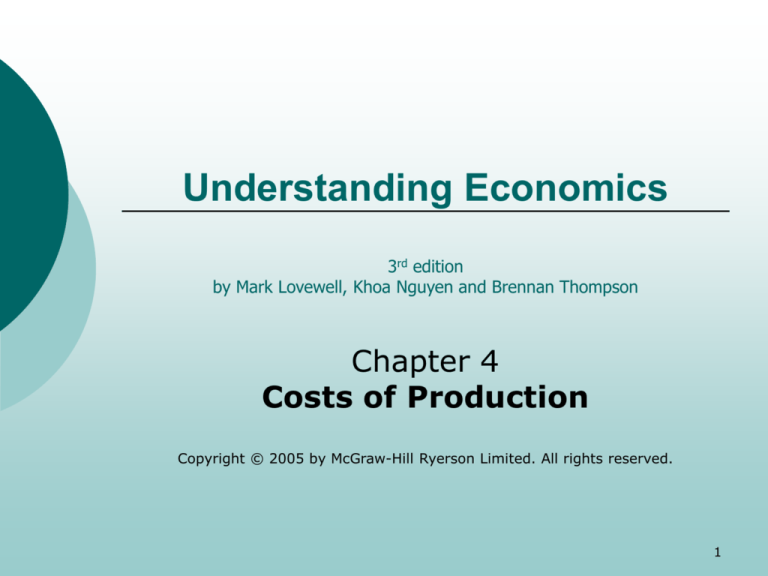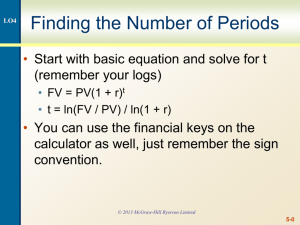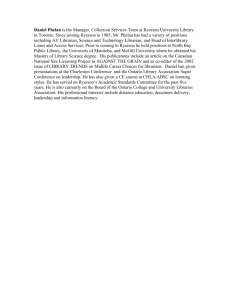
Understanding Economics
3rd edition
by Mark Lovewell, Khoa Nguyen and Brennan Thompson
Chapter 4
Costs of Production
Copyright © 2005 by McGraw-Hill Ryerson Limited. All rights reserved.
1
Learning Objectives
In this chapter you will:
1.
2.
3.
4.
learn about economic costs (explicit and
implicit) of production and economic profit
analyze short-run (total, average, and
marginal) products, and the law of
diminishing marginal returns
derive short-run (total, average, and
marginal) costs
examine long-run results of production
(increasing returns to scale, constant to scale,
and decreasing to scale) and long-run costs
Copyright © 2005 by McGraw-Hill Ryerson Limited. All rights reserved.
2
T 1, Production,costs, and profit
Define:”business”,”production”,”inputs”,”output”,
See page 85.
Types of Production
There are three main sectors in the economy
•
•
•
the primary sector consists of industries that
extract or cultivate natural resources
the secondary sector consists of industries that
fabricate or process goods
the service sector consists of trade and
information industries
Copyright © 2005 by McGraw-Hill Ryerson Limited. All rights reserved.
3
Productive Efficiency
Productive efficiency: making a given
quantity of output at the lowest cost
Businesses choose from different
production processes
•
•
a labour-intensive process employs more
labour and less capital
a capital-intensive process employs more
capital and less labour
Copyright © 2005 by McGraw-Hill Ryerson Limited. All rights reserved.
4
Economic Costs & Economic profit
Economic costs include
explicit costs: payments made by a
business to business or people outside of it
•
implicit costs:the owner’s opportunity
costs of being involved with a business.
•
Economic costs = explicit costs + implicit
costs
Economic profit: the excess of a business’s
total revenue over its economic costs
•
•
•
Accounting profit: the excess of a business’s
total revenue over its explicit costs
Economic profit = total revenue – economic
costs
Copyright © 2005 by McGraw-Hill Ryerson Limited. All rights reserved.
5
Accounting Vs. Economic Profit
Accounting profit is total revenue
minus explicit costs
Because accountants only consider
explicit costs, accounting profit
always exceeds economic profit by
the amount of the business’s implicit
costs.
Copyright © 2005 by McGraw-Hill Ryerson Limited. All rights reserved.
6
T 2, Production in the Short Run (a)
In the short run
•
some inputs (such as capital) are fixed
•
other inputs (such as labour) are variable
Inputs are combined to make a business’s
total product
•
Total product: the overall quantity of
output produced with a given workforce
•
average product is total product divided
by the number of workers
•
marginal product is the extra total
product with an additional worker
Copyright © 2005 by McGraw-Hill Ryerson Limited. All rights reserved.
7
Average product = total product (q)
number of workers (L)
Marginal product
= change in total product (Δ q)
change in workforce (Δ L)
Copyright © 2005 by McGraw-Hill Ryerson Limited. All rights reserved.
8
The Law of Diminishing Marginal
Returns
Short-run production is determined
by the law of diminishing marginal
returns
the law of diminishing marginal returns:
•
At some point, as more units of a variable
input are added to a fixed input, the marginal
product will start to decrease
average product also falls after some
point
Copyright © 2005 by McGraw-Hill Ryerson Limited. All rights reserved.
9
Relating Average and Marginal
Values
Average and marginal values are
related using three rules
•
•
•
if an average value rises then the
marginal value must be above the
average value
if an average value falls then the marginal
value must be below the average value
if an average value stays constant then
the marginal value must equal the
average value
Copyright © 2005 by McGraw-Hill Ryerson Limited. All rights reserved.
10
Total, Marginal, and Average Products
Total
Product
(q)
(workers (T-shirts
per day) per day)
0
0
1
80
2
200
3
250
4
270
5
280
6
270
Marginal
Product
(Δq/ΔL)
(T-shirts
per day)
80
120
50
20
10
-10
Average
Product
(q/L)
(T-shirts
per day)
80
100
83.3
67.5
56
45
300
250
TP
200
150
100
50
0
--
1
2
3
4
5
6
Number of Workers Employed per Day
T-Shirts Produced per Day
Labour
(L)
T-Shirts Produced per Day
Figure 4.2, Page 89 and Figure 4.3, Page 91
Diminishing
returns set in
120
100
80
60
AP
40
20
0
-20
1
2
3
4
5
6
MP
Number of Workers Employed per Day
Copyright © 2005 by McGraw-Hill Ryerson Limited. All rights reserved.
11
T 3, Costs in the Short Run
Short-run costs include
•
•
•
fixed costs (costs of all fixed inputs)
variable costs (costs of all variable inputs)
total cost (fixed costs + variable costs)
Marginal Cost (a)
Marginal cost is the extra cost of producing an
extra unit of output
•
it equals the change in total cost divided by the
change in total product
The marginal cost curve is shaped like a “J”
because of the law of diminishing marginal
returns
Copyright © 2005 by McGraw-Hill Ryerson Limited. All rights reserved.
12
Marginal Cost (b)
Figure 4.6, Page 93
12
MC
10
$ per T-Shirt
8
6
Diminishing
returns set in
4
2
0
50
100
150
200
250
300
Quantity of T-Shirts Produced Per Day
Copyright © 2005 by McGraw-Hill Ryerson Limited. All rights reserved.
13
Per-Unit Costs
Per-unit costs include
•
•
•
average fixed cost (fixed costs divided by total
product)
AFC = FC/Q
average variable cost (variable costs divided by
total product)
AVC = VC/Q
average cost
either total cost divided by total product
or average fixed cost + average variable
cost
AC= AFC + AVC
Copyright © 2005 by McGraw-Hill Ryerson Limited. All rights reserved.
14
Short-Run Costs for Pure ‘n’ Simple TShirts
Figure 4.5, Page 93
Labour
(L)
Total Marginal Fixed Variable
Product Product Costs Costs
(MP)
(q)
(FC)
(VC)
0
0
1
80
2
200
3
250
4
270
5
280
80
120
50
20
10
Average
Marginal Average
Average
Cost
Cost
Fixed Costs Variable
(AC)
(MC)
(AFV)
Costs
(ΔTC/Δq)
(FC/q)
(AVC) (AFC + AVC)
(VC/q)
Total
Cost
(TC)
(FC + VC)
$825
$0
$825
825
140
965
825
300
1125
825
425
1250
825
535
1360
825
640
1465
140
$1.75
160
1.33
125
2.50
110
5.50
105
10.50
$10.31
$1.75
$12.06
4.13
1.50
5.63
3.30
1.70
5.00
3.06
1.98
5.04
2.95
2.29
5.24
Copyright © 2005 by McGraw-Hill Ryerson Limited. All rights reserved.
15
The Family of Short-Run Cost Curves
Figure 4.7, page 95
12
MC
$ per T-Shirt
10
8
6
AC
b
4
AFC
AVC
2
a
0
50
100
150
200
250
300
Quantity of T-Shirts Produced Per Day
Copyright © 2005 by McGraw-Hill Ryerson Limited. All rights reserved.
16
T 4, Returns to Scale (a)
All inputs can be changed by the
same proportion in the long run
increasing returns to scale means
the % change in output > the %
change in inputs
constant returns to scale means
the % change in output = the %
change in inputs
decreasing returns to scale
means the % change in output <
the % change in inputs
Copyright © 2005 by McGraw-Hill Ryerson Limited. All rights reserved.
17
Returns to Scale (b)
Increasing returns to scale are caused by
the division of labour or specialized
capital or specialized management (see
page 97)
Constant returns to scale arise whenever
making more of a product means
repeating exactly the same tasks
Decreasing returns to scale are caused
by management difficulties or limited
natural resources (see page 98)
Copyright © 2005 by McGraw-Hill Ryerson Limited. All rights reserved.
18
Costs in the Long Run (a)
Long-run average cost is the
minimum short-run average cost at
every output
The long-run average cost curve is
saucer-shaped because of various
ranges of returns to scale
•
•
•
initial range of increasing returns to scale
middle range of constant returns to scale
final range of decreasing returns to scale
Copyright © 2005 by McGraw-Hill Ryerson Limited. All rights reserved.
19
Costs in the Long Run (b)
Figure 4.8, page 99
Long-Run Average Costs
AC4
$ per Magazine
AC1
AC2
Range A
Long-Run AC
AC3
Range B
Range C
Quantity of Magazines per Week
Copyright © 2005 by McGraw-Hill Ryerson Limited. All rights reserved.
20
Costs in the Long Run (b)
Figure 4.9, page 100
Possible Long-Run Average Costs
$ per Unit
$ per Unit
$ per Unit
Quantity of Output
Extended Range of
Decrease Returns
to Scale
Extended Range of
Constant Returns
to Scale
Extended Range of
Increasing Returns
to Scale
Quantity of Output
Quantity of Output
Copyright © 2005 by McGraw-Hill Ryerson Limited. All rights reserved.
21




